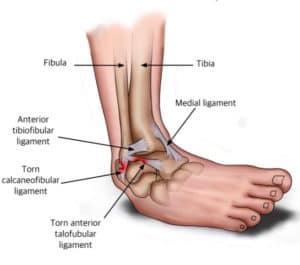Have you sprained an ankle? Ankle sprains are pretty darn common. About 14% of all emergency room visits are because of ankle issues, and 70% of those are sprains! Unfortunately, a lot of people continue to have problems after an ankle sprain, whether it’s pain, feelings of instability, or recurrent injuries. Almost half of people have persistent issues – which makes us wonder, are we doing our job as healthcare providers to treat these appropriately?
Read on to find out:
- What exactly is an ankle sprain and how is it diagnosed?
- How is it treated?
- How can I prevent more pains and sprains?
What is an ankle sprain and how is it diagnosed?
The word sprain refers to stretching or tearing of a ligament. A ligament is a band of tissue that connects one bone to another. There are lots of ligaments attaching various bones in the foot and ankle, but an ankle sprain most commonly refers to a ligament on the outside that attaches a bone in the foot to a bone on the outside of the lower leg. (See the anterior talofibular ligament in the picture below) This ligament gets stretched or even torn when your foot lands in a downward, inward position – like when you land from a jump and your ankle rolls underneath you.
It’s not super difficult to diagnose a lateral ankle sprain, as the diagnosis is based on how it happened and where the pain and swelling are located. After an ankle sprain, you’ll feel pretty immediate pain around the outside of the ankle. Depending on the severity, the ankle will swell and putting weight on that leg may be difficult. The location of pain and swelling, combined with the mechanism of injury and a few hands-on tests can rule in a lateral ankle sprain pretty quickly. In addition, it’s important to see a healthcare provider to rule out anything else, like a broken bone. Since fractures can happen alongside ankle sprains, certain cases require x-rays to ensure proper treatment.
Once you’re cleared of broken bones, the ankle sprain can be classified by severity based on swelling and some other hands-on tests. The classification will help guide treatment and determine how long it’ll take to get back to your usual routine.
How is an ankle sprain treated?
How many of you just walked it off? It’s a bit concerning that many people don’t receive any care after an ankle sprain, especially when factoring in the high rates of recurrent pain, instability and injury. Studies suggest that long-term instability, when untreated, may even lead to ankle arthritis.
Depending on the severity of the sprain, you may have to use crutches for a short period of time until walking is tolerable. After that, you’ll gradually progress back to regular activities like running and jumping. Oftentimes, this progression isn’t supervised and is done pretty rapidly – increasing the risk that you’ll re-sprain the ankle and have persistent ankle issues.
Though physical therapy isn’t commonly prescribed after an ankle sprain, we think it should be! Physical therapists can help restore normal ankle motion, which is commonly impaired after a severe sprain, and can then contribute to other issues including knee pain and shin splints. A physical therapist will also give you strength exercises for your foot, ankle and even hips to get the ankle feeling better and decrease your chances of this happening again.
How to prevent future pains & sprains
Even though it may seem like it’s ‘just a sprain’, keep in mind that it can have long-term consequences if not treated appropriately. Early movement, hands-on therapy, exercise and bracing are highly recommended to optimize outcomes after spraining your ankle. See a physical therapist to make sure you’re doing the right things to prevent persistent pain and future injury. Give us a call today to find out how we can help!



